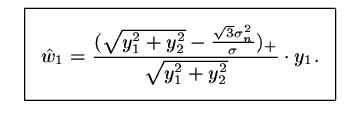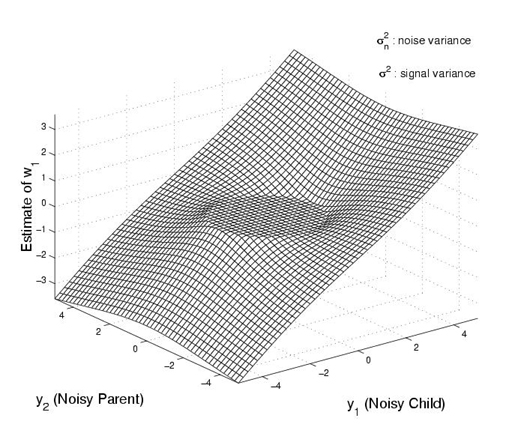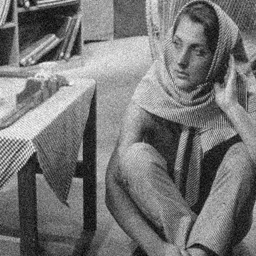Bivariate Shrinkage Functions for Wavelet Based Denoising
We have proposed a new simple non-Gaussian bivariate probability distribution function to model
the statistics of wavelet coefficients of natural images. The model captures the dependence
between a wavelet coefficient and its parent. Using Bayesian estimation theory we derive from
this model a simple non-linear shrinkage function for wavelet denoising, which generalizes the
soft thresholding approach of Donoho and Johnstone. The new shrinkage function, which
depends on both the coefficient and its parent, yields improved results for wavelet-based
image denoising.
Let w2 represent the parent of w1 (w2 is the wavelet coefficient at the same spatial position
as w1, but at the next coarser scale). Then

where w = (w1,w2), y = (y1,y2) and n = (n1,n2). The noise values n1, n2 are iid zero-mean Gaussian with variance \sigma_n^2. Based on the empirical histograms we have computed, we propose the following non-Gaussian bivariate pdf

With this pdf, w1 and w2 are uncorrelated, but not independent. The MAP estimator of w1 yields the following bivariate shrinkage function

For this bivariate shrinkage function, the smaller the parent value, the greater the shrinkage. This is consistent with other models, but here it is derived using a Bayesian estimation approach beginning with the new bivariate non-Gaussian model. The plot is illustrated in the figure below.

Fig. 2.1 A bivariate shrinkage function.
This bivariate shrinkage function can be implemented as
the matlab function bishrink.m as follows
Table 2.3 Matlab function bishrink.m
function [w1] = bishrink(y1,y2,T) % Bivariate Shrinkage Function % Usage : % [w1] = bishrink(y1,y2,T) % INPUT : % y1 - a noisy coefficient value % y2 - the corresponding parent value % T - threshold value % OUTPUT : % w1 - the denoised coefficient R = sqrt(abs(y1).^2 + abs(y2).^2); R = R - T; R = R .* (R > 0); w1 = y1 .* R./(R+T);
2. Local Adaptive Image Denoising
Using the bivariate shrinkage function above, we developed an effective and low
complexity locally adaptive image denoising algorithm in [2].
This shrinkage function requires the prior knowledge of the noise variance and
and the signal variance for each wavelet coefficient. Therefore the algorithm
first estimates these parameters (see [2] for the recipe of the estimation rules).
Briefly, the algorithm is summarized as follows:
- Calculate the noise variance.
- For each wavelet coefficient,
- Calculate signal variance,
- Estimate each coefficient using the bivariate shrinkage function.
The following sections describe the implemetation of this algorithm using both
the seperable DWT and the complex dual-tree DWT. (Necessary programs are provided).
2.1 Matlab implementation of wavelet-based denoising using the separable DWT
2.2 Matlab implementation of wavelet-based denoising using the dual-tree DWT
3. Examples:
Original Image  View full size image |
Noisy Image 
View full size image |
Denoised Image (Seperable DWT) 
View full size image |
Denoised Image (Dual-tree DWT) 
View full size image |
4. References:
[1] : L. Sendur, I.W. Selesnick,
"Bivariate shrinkage functions for wavelet-based denoising exploiting interscale dependency",
IEEE Transactions on Signal Processing, 50(11), 2744-2756, Nov 2002.
[2] : L. Sendur, I.W. Selesnick,
"Bivariate shrinkage with local variance estimation",
IEEE Signal Processing Letters, 9(12), 438-441, Dec 2002.
[3] : L. Sendur, I.W. Selesnick,
"A bivariate shrinkage function for wavelet-based denoising",
IEEE International Conference on Acoustics, Speech, and Signal Processing, 2002.
[4] : L. Sendur, I.W. Selesnick,
"Subband adaptive image denoising via bivariate shrinkage",
IEEE International Conference on Image Processing (ICIP), 2002.